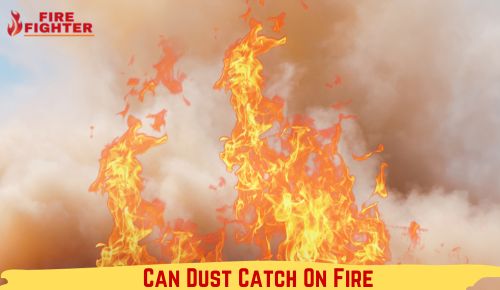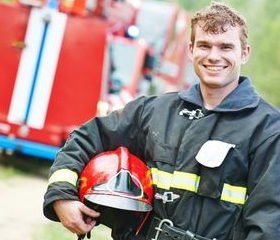Can Dust Catch On Fire? The Truth Revealed
Can dust catch on fire? It’s a question that has intrigued scientists and homeowners alike. We’ve all heard horror stories of houses burning up due to seemingly innocent piles of dust. But is there any truth to these claims?
This blog will explore the science behind dust and fire, examining whether dust poses a fire hazard and what precautions you can take to keep your home safe. So, let’s dig deep into the world of dust and discover the truth behind its fiery potential.

Contents
Can Dust Catch On Fire
Dust can catch on fire. Dust is made up of tiny particles that can easily become airborne. When these particles are concentrated and come into contact with an ignition source, such as an open flame, a spark, or even a hot surface, they can ignite and cause a fire to start.
One of the most common sources of dust fires is in industrial settings, particularly those involving fine powders like coal, flour, or sawdust.
These materials have a high surface area, generating significant heat when ignited. Their fine particles can also easily disperse into the air, creating a highly flammable environment.
Is Dust Highly Flammable?
Dust can be highly flammable under certain conditions. The flammability of dust depends on several factors, including the type of dust, its particle size, concentration in the air, and the presence of an ignition source.
Certain types of dust, such as finely powdered metals (e.g., aluminum, magnesium, titanium), organic materials (e.g., flour, sugar, sawdust), and chemical powders, can be highly flammable or even explosive when dispersed in the air in the form of a fine dust cloud.
When these dust clouds encounter an ignition source, such as an open flame, spark, or even static electricity, they can ignite and result in a dust explosion.
Why Do Dust Fires Happen?
Dust fires, also known as dust explosions, occur when certain conditions allow combustible dust to ignite and rapidly release energy, such as a fireball or explosion. Several factors contribute to the occurrence of dust fires:
Presence of Combustible Dust: The primary factor is the presence of combustible dust, which can be finely powdered materials such as metals (e.g., aluminum, magnesium), organic materials (e.g., flour, sawdust), or chemical powders. These materials must be finely divided into small particles to become combustible.
Dust Cloud Formation: Dust fires can happen when flammable particles become airborne from pouring, mixing, or poorly ventilated areas.
Oxygen: For combustion to occur, oxygen (or another oxidizer) must be present. In most industrial settings, the air has an adequate oxygen supply.
Ignition Source: An ignition source is required to initiate the combustion of the dust cloud. This can be a flame, spark, hot surface, or static electricity discharge. Sometimes, dust layers or settled dust can accumulate heat and ignite spontaneously.
Confinement: Dust explosions often happen in confined spaces, which can increase the intensity of the explosion. The confined space allows pressure to build up more quickly, resulting in more explosions.
Dust Concentration: The concentration of dust in the air must be within a certain range known as the “explosive limits” for the particular dust material. If the dust concentration is too low or too high, it may not ignite or burn less explosively.
Is Dust Explosive?
Not all types of dust are explosive, but certain materials have the potential to ignite and cause a catastrophic explosion under the right conditions.
Combustible dust is a fine particulate material that can catch fire and explode when dispersed in the air, reaching a certain concentration and coming into contact with an ignition source.
So, what are the common sources of combustible dust? Many industries handle materials that can produce combustible dust, such as grain, flour, sugar, coal, wood, plastics, and many more.
Dust buildup is explosive when conditions are right. It can be collected on floors, storage, ventilation, and equipment surfaces.
The conditions required for a dust explosion are often called the “dust explosion pentagon.”
This pentagon includes five elements: combustible dust, oxygen, an ignition source, dispersion of dust particles, and confinement of the dust cloud. When these elements come together, it creates a recipe for disaster.
At What Temperature Will Dust Ignite?
The ignition temperature of dust depends on its characteristics. Autoignition is the lowest temperature at which a dust or powder will self-ignite without an external ignition source like an open flame or spark.
Here are some approximate autoignition temperatures for a few common dust materials:
- Wood Dust: Approximately 260-450°C (500-842°F)
- Flour Dust: Approximately 340-450°C (644-842°F)
- Coal Dust: Approximately 450-650°C (842-1202°F)
- Aluminum Dust: Approximately 650-760°C (1202-1400°F)
- Magnesium Dust: Approximately 650-700°C (1202-1292°F)
- Sulfur Dust: Approximately 232°C (450°F)
How Do You Extinguish Dust Fires?
Flammable dust poses risks of fires and explosions. If one occurs, knowing how to handle it is crucial due to quick energy release and potential secondary explosions. Prevention is always the top priority. Here are some general guidelines for responding:
Evacuation and Safety: The safety of personnel should be the top priority. If a dust fire or explosion occurs, evacuate immediately and follow established safety procedures.
Shutdown Equipment: If safe, shut down any equipment or processes contributing to the dust fire or explosion.
Isolate the Area: Isolate the affected area to prevent the spread of the fire or explosion. Close doors and barriers if possible.
Ventilation: Ensure that ventilation systems are turned off to prevent the spread of dust and fire. Ventilation can introduce oxygen and potentially exacerbate the situation.
Fire Suppression: Avoid using water to put out dust fires as it may worsen things. Use dry chemical extinguishers or CO2 to extinguish the flames safely.
Safety Personnel: Trained personnel with appropriate firefighting equipment and knowledge of dust fire hazards should handle the situation. They should use specialized equipment designed for dust-fire scenarios.
Prevent Re-Ignition: Monitor the area to prevent re-ignition of any remaining dust clouds or hot spots. Ensure that equipment or processes are thoroughly inspected and cleaned before restarting.
Investigation: After the incident is under control, conduct a thorough investigation to determine the cause of the dust fire or explosion. This can help prevent future incidents through improved safety measures and procedures.
Flammable Dust Examples
Various examples of flammable dust can be categorized into different groups based on their composition or origin. Here are some common examples of flammable dusts:
Metal Dust
Aluminum Dust: Finely powdered aluminum can be highly flammable and is a common dust hazard in metalworking and aluminum processing industries.
Magnesium Dust: Like aluminum, finely divided magnesium dust is highly flammable and poses a significant fire risk, especially in industries that use magnesium alloys.
Titanium Dust: Titanium dust is combustible and can ignite when dispersed as a fine powder. It is a concern in industries like aerospace and welding.
Organic Dusts
Wood Dust: Sawdust and wood shavings can be combustible. They are often found in woodworking, sawmills, and paper processing facilities.
Flour Dust: Flour and grain dust can be highly flammable. The baking and food processing industries need to manage the risks associated with flour dust.
Sugar Dust: Sugar is another organic material that can form explosive dust clouds if finely powdered. This is a concern in the food industry.
Plastic Dust: Certain types of plastic dust, such as polyethylene or polypropylene, can be flammable and pose a fire hazard in plastic manufacturing and recycling facilities.
Chemical Dusts
Chemical Powders: Dust from certain chemicals can be flammable, especially if finely divided and dispersed into the air.
Other Dusts
Coal Dust: Coal dust is known to be combustible and has been a concern in mining and coal processing industries.
Sulfur Dust: Sulfur dust can be flammable under certain conditions and is found in sulfur processing and mining industries.
Safety Precautions For Dust Fires
Safety precautions for preventing dust fires and dust explosions are crucial in industries and environments with combustible dust.
These precautions are essential to protect the safety of workers, prevent property damage, and ensure compliance with safety regulations. Here are some key safety precautions for mitigating the risks associated with dust fires:
Dust Management: Implement a comprehensive dust management program with regular cleaning, removal, and housekeeping procedures.
Use dust collection systems and equipment, such as industrial vacuum cleaners, to capture and contain dust at the source.
Ventilation: Maintain proper ventilation systems to control and reduce dust concentrations in the air.
Ensure ventilation systems are properly designed and regularly inspected to prevent dust buildup.
Explosion Venting and Suppression: Install explosion venting systems and suppression systems in areas with a high risk of dust explosions to mitigate the impact of an explosion if it occurs.
Dust Control Measures: Implement engineering controls, such as dust containment systems and collectors, to prevent dust from becoming airborne.
Use wet methods or dust suppressants to reduce dust generation during cutting, grinding, or handling.
Minimize dust dispersion using appropriate equipment and techniques, such as dust curtains or enclosures.
Equipment Design: Use explosion-proof equipment and electrical systems where combustible dust may be present.
Ensure that equipment is properly grounded to prevent the buildup of static electricity.
Worker Training and Awareness: Train employees and contractors on the hazards of combustible dust, including the potential for dust fires and explosions.
Promote a culture of safety where workers are encouraged to report unsafe conditions or practices.
Control Ignition Sources: Control potential ignition sources such as open flames, sparks, hot surfaces, and electrical equipment.
Implement static electricity control measures, such as bonding and grounding, in areas with a risk of static discharge.
Risk Assessment: Conduct regular risk assessments and hazard analyses to identify areas and processes with a high risk of dust, fires, and explosions.
Develop and implement specific safety procedures and protocols for high-risk areas.
Safety Standards and Regulations: Comply with relevant safety standards and regulations, such as those provided by organizations like OSHA (Occupational Safety and Health Administration) in the United States, that address combustible dust hazards.
Emergency Response Plan: Develop and regularly update an emergency response plan that outlines procedures for responding to dust fires or explosions, including evacuation routes and communication protocols.
Regular Inspections and Maintenance: Regularly inspect and maintain equipment, machinery, and safety systems to ensure they are in good working condition.
Documentation and Record-Keeping: Maintain records of dust control measures, inspections, training, and incident reports.
Review and Improvement:
Continuously review and improve safety protocols based on lessons learned from incidents and near-misses.
Conclusion
Dust can catch on fire when certain conditions are met. When finely dispersed in the air, combustible dust can ignite in the presence of an ignition source, such as an open flame, spark, or static electricity.
The type of dust, its particle size, concentration, and the presence of oxygen all play critical roles in the flammability of dust.
Industries that handle materials prone to dust fires take extensive precautions to prevent dust explosions, including proper dust management, ventilation, equipment design, and worker training, to minimize the risks associated with combustible dust.

Hi, I m Aaron Smith, a firefighter, and creator of Firefighterline.com, a website that provides top-notch training courses for firefighting organizations. After completing my studies, I quickly rose through the fire service ranks, eventually becoming Captain at one of the busiest fire departments in the state.

